I had a dream.
When I dream, and I often do, I sometimes decide to fly: it is always a matter of a low flight, topographic, almost like an induced levitation that enables me to distinguish forests of different colours, fields, urban areas, plots, including people and animals. Everything in these dreams is clear and all the elements in the landscape have a name, as in a children’s story: things are by no means as simple as that when we are awake. And this is unsettling, because I have always believed that the world of our dreams is much more complex and labile than the real one.
Why are we unable to call things with their proper name in terms of landscape? Why, from certain coordinates in Southern Europe, do we fail or struggle to name what we could call Landscapism?
Are we aware of the professional weakness which reveals the absence of a definition of the discipline of landscape design in texts, conferences or congresses?
In the final analysis, the sum of definitions of Landscape or Landscapism has made the question become banal, and this is even truer with respect to the content of the relevant answers, which often seek enlightenment in etymology or in some concept so universal as to lack focus (for instance “Landscapism is the discipline which regulates the unconstructed”).
I always remember the illuminating answer of an extraordinary architect and university professor who, when I asked him clarifications as to the identity of the landscape, answered with light sarcasm that he had dedicated himself exclusively to the landscape for almost twenty years in a professional and academic context, without knowing exactly in what it consisted.
While running the risk of making matters too concrete, but with the intention of clarifying them, two texts are fundamental with regard to this aspect: one, with an artistic air, by Javier Maderuelo: El Paisaje: Genesis de un concepto, Edizioni Araba, Madrid 2005, which already as of the first chapter provides a clear definition of the discipline of Landscapism with clarity and without giving rise to speculation, and another significant and surprising one by Franco Zagari: Questo é paesaggio: 48 definizioni, Mancuso Editore, Rome 2006, in which the author explores the opinions and disagreements associated with the concept of Landscapism.
Landscapism, Architecture of the Landscape or Architecture in the Landscape
The term Landscapism, coined in France to define this discipline, which is much more precise than the American one of Landscape Architecture, confronts those who feel more comfortable, for some reason or other, as educational background or supposed prestige, with the word Architecture.
In this context it is interesting to seek to clarify the meaning and relevance of a variety of terms, from Landscapism to Landscape Architecture, to the diaphanous Architecture in the Landscape, often confused with other disciplines, also seen from another angle, close to architectural studies.
The discipline is today often analysed with an eye to its conceptual transversal nature, the sum of layers of information that it manages, the undefined nature of its limits, or the fact that one often runs the risks of approaching it from borderline areas with other disciplines, or even its ability to provide adequate solutions to newly formulated problems.
Landscapism has recently been attributed an important role for purposes of meeting the complex necessities of ancient territories. Analogously, on the contrary, conservative approaches, prejudices on the expertise or insufficient or too one-sided information seek to relegate it to the absurd role of “architecture of exteriors”, something that deprives it of the indispensable disciplinary intensity required for dealing with the landscape, to act as bridge between the process-related and formal solutions on the one side, and the environmental and more concretely ecological contents on the other.
The difficulties associated with working on the Landscape on the basis of Architecture, not only with the necessary sensibility but with knowledge of and familiarity with the ecological interpretation of the place, controlling the effect which the designed element makes on the surroundings, is reflected in the work of a few designers. As compared to certain examples in painting, the landscape is something that goes beyond the creative attitude of Renaissance-type perspective vistas (Paolo Uccello, Luca della Robbia, Giorgione, etc.) or the concept of the static “backdrop and figure” of European art history; indeed, it is much closer to an intuitive interpretation of the surroundings, as witnessed by the graphic work of Pablo Palazuelo (La geometria i la vida, Carmen Bonell, Ed. Cendeac, 2006).
Relevant projects that are particularly significant, as the museum of cave paintings of Niaux (Francia) by Massimiliano Fuksas, Franco Zagari, Jean Louis Fulcrand, G. Jourdan, J. Capia and A. Marguerit (photo 1), the pedagogic design work of the itinerary and belvedere of Cardada in the Swiss Alps by Paolo Bürgi (photo 2) or the subtle interpretation of the existing structures in the escalators of Granja in Toledo by Elias Torres and J. Antonio Martinez Lapeña (photo 3), are examples of three different yet harmonized ways to obtain the creative energy from the place necessary to give impulse to a project that in every case comes to reflect the characters of the landscape and to make it possible to understand it better. And this is not only a matter of appreciating the genius loci; it is also a delicate task that calls for an adequate programmatic argument and a certain distrust in nature’s capacity to phagocytize good architecture.
It would be convenient to discern, also among what we will call Landscapism, whose design soul nevertheless has its origin in an artistic genesis, not very far removed from the positions of Land-art or more precisely those of the group that goes by the name of Earthworks, as the magnificent and famous rest area in Malniu by Enric Batlle and Joan Roig, or as the more recent and less famous and valid projects in the Park of the “pedra tosca”, in the vicinity of Olot (Girona), by RCR-Aranda, Pigem and Vilalta.
An inter-European confrontation.
Concepts of landscape in Europe is vary considerably; the traditional approach centres on gardening and the techniques that have made it possible, as opposed to projects based on large-scape landscapes of great beauty.
The interpretation of landscapism of Romantic origin and Saxon ascendency defines a discipline in which “the green” seems intrinsic, and where the limits are only approximate.
It is in the last few decades, inspired by the evidence of a civilizing environmental crisis, that the peculiarities of landscapism have become blurred and one has once again appreciated the responsibility linked to solving problems that the classical disciplines have been unable to tackle, as they lack the necessary instruments.
The emergence of landscapism as a discipline in the Mediterranean, which has coincided with the aforesaid moment, the diversity of the territorial problems, the maturity of our landscapes which have been built on repeatedly in the same locations, the social awareness and the urgency of finding adequate solutions to complex problems, have made it necessary to update the discipline, on the basis of interdisciplinary knowledge.
Very different from the Nordic model of “greenery”, the Mediterranean landscapes, conditioned by the climatic changes, with an agonizing agriculture and shorelines that are almost wholly consumed by tourist facilities, are governed by a neo-urbanism whose models have by now become obsolete.
This gap has been one of the constants observable at the last European Landscape Biennial, where the recommendation to choose only one project, as representative of the more than 500 projects submitted, for the “Rosa Barba” landscape prize, has led – not without some difficulty – to a tied first prize. It has not be a matter of a political or aesthetic decision, but of a disagreement among the members of the prestigious and extremely conscientious international jury which, faced with the task of rewarding one exemplary work among all those realized in the last few years, has been unable to reach an agreement, as its members advocated divergent, perhaps irreconcilable positions with regard to landscapism.
This is undoubtedly a matter of different backgrounds and geographic contexts, which give rise to landscape problems of very diverse landscape problems.
The awareness of the crisis
The clear tendency observable at the European Landscape Biennial of Barcelona is that this situation is appreciated, something that is also witnessed by the titled of the symposium, aimed at orienting the certamen and the relative proposals. The themes “Remaking landscapes”, “Insurgent Gardens”, “Alone with nature” or “Landscape: production” aim to approach the topicality of landscapism from a perspective linked to mature territories and innovative instruments of landscape production, in an attempt to find solutions capable of meeting the demanding contemporary needs.
The themes of the last Landscape Biennials of Barcelona have centred on an in-depth analysis of the most crucial aspects of the great crisis which not only affects the economy, in terms of models and disciplines that are not only related to the landscape, but the creative world in general.
In the case of landscapism, this situation has been aggravated by the environmental condition of our territories, which more than ever call for not only substantial economic investments but also a careful reflection concerning the ideas and necessities associated with the innovation.
The difficult social conjecture, the integration of renewable energies, the pollution of air and water, the fragility of our coasts and the climatic changes caused by global warming, as well as unscrupulous developments of tourist facilities in fragile territories, are some elements on which town planners in general, and landscapists in particular, should work. This is why “Tormenta e impetu”, “Liquid landscapes” and this last edition, “Biennale against Biennale”, have been indispensable as heralds and initiators of a disciplinary debate from different points of view, with regard to the path we ought to choose in the near future.
Our models are being exhausted and our landscape references are in need of a review, because some design methods and management approaches will be impossible to use in the future.
Even if all this is very serious, it also represents a fascinating study on an international level, as a design reflection and an opportunity to relate in a discipline whose qualities depend on agile responses, relational skills and a confidence in the development of complex design processes based on rigour, familiarity with places and techniques.
The destiny has a “chance” sin store for us.
In a world of insecurity and uncertainty we are trying to call things with their proper name.
Landscapism is dead, long live Landscapism.
Jordi Bellmunt Chiva is Professor in the Department of Urban and Regional Planning of the University of Catalonia and Director of the Master of Landscape Architecture (UPC).
He works as landscape architect since 1980. Thanks to a multidisciplinary methodology he developed projects at large and small scale, enriching his professional work with forefront topics of the research and academic teaching.
The office B’ Architectes, founded in 1994, develops mainly landscape projects and urban design.








